Features
In March 2020, the World Health Organization declared a global COVID-19 pandemic and the UK announced a strict national lockdown. When Oxford University scientists were sent home, they rolled up their sleeves, switched on their computers and started to help develop new drugs to target SARS-CoV-2, the virus that causes COVID-19.
‘What is remarkable about this collaboration, involving 29 scientists from around world, is that every meeting was entirely virtual, with many collaborators yet to meet face-to-face.’ Prof. Garrett M. Morris, Oxford University.
It began with a small group of scientists and their graduate students at the University of Oxford, who were joined by colleagues from Bristol University, Diamond Light Source and academics in France, Italy, and Spain – all working from home but coming together weekly on Zoom to tackle this terrifying disease.
Thus began an international collaboration involving 29 scientists around the world focused on understanding how SARS-COV-2 makes its worker proteins at the molecular level so we could develop novel antiviral drugs and block their production.
‘This collaboration has really shown how sharing of models, data and expertise can help get answers and understanding much more quickly. It’s how science should be done – particularly in the face of pressing problems like the Covid pandemic.’ Prof. Adrian Mulholland, Bristol University
Despite the development of successful vaccines in record time, there are no drugs that have been designed specifically to target COVID-19, but they are desperately needed.
Once SARS-CoV-2 has invaded a healthy human cell, the virus's own genetic material commandeers the infected cell's machinery, forcing it to make new copies of the virus.
The new virus begins as one long protein that cuts itself into functional units. First the cutting catalyst or 'protease' cuts itself out, which then cuts at multiple other positions.
‘The opportunity to apply our basic science on enzymes to a problem of enormous societal value in a fantastically collaborative manner was a wonderful life experience.’ Prof. Chris Schofield, Oxford University.
SARS-CoV-2 has two molecular machines or proteases that resemble 'molecular scissors'. One of these, called the main protease, or 'Mpro' for short, cuts at no less than 11 of these cut sites.
If scientists can design new molecules that bind more tightly than these natural substrates, they could stop the virus dead in its tracks. Blocking the cutter stops the virus from replicating—a strategy that has worked for treating other viral diseases like HIV and hepatitis.
Using 3D structures obtained by shining X-rays onto crystals of the main protease of SARS-CoV and SARS-CoV-2, Prof. Morris and his collaborators were able to develop computational models of how the SARS-CoV-2 Mpro binds to its 11 cut sites. From these models, they were able to gain key insights into how these viral Mpro 'molecular scissors' work.
Building on this knowledge, and using computational methods, they next sought to design novel molecules that could bind even more tightly than the natural cut sites. Using computers to sift through just over 200 trillion possibilities, they proposed new molecules that would stop the virus from maturing.
‘This experience taught me that science can be carried out regardless of working conditions, when a group of enthusiastic and motivated people gather together’. Luigi Genovese, CEA France.
All 11 cut sites and 4 of these designed peptides were synthesized and tested in the laboratory of Prof. Chris Schofield in the Chemistry Research Laboratory at the University of Oxford. The experiments showed that the novel designed peptides not only bound to the molecular scissors but blocked the substrates and actually inhibited the Mpro.
Scientists also carried out an extensive analysis of hundreds of published 3D structures of small molecules bound to Mpro and predicted how inhibitors designed by the COVID Moonshot would bind, figuring out how these 'molecular keys' fitted into the 'molecular lock' of Mpro, and using these insights to propose how to design new drugs to treat COVID-19.
‘Ironically, the busiest time of my PhD was when I was sitting at home during lockdown, working on the collaboration. The weekly, big zoom meetings created a great structure in an otherwise monotonous ‘lockdown-life’ schedule.’ Marc Moesser, Department of Statistics, Doctoral Student.
The team combined their expertise, applying a wide range of computational modelling techniques to build a complete picture of SARS-CoV-2 Mpro.
Much of the work was carried out by four graduate students: Henry Chan, Marc Moesser and Tika Malla at Oxford University, and Becca Walters at Bristol University.
These techniques ranged from comparative molecular modelling, molecular dynamics, interactive molecular dynamics in virtual reality, quantum mechanics, computational peptide design, protein-ligand docking, protein-peptide docking, to protein-ligand interaction analysis.
The team included: Prof. Garrett M. Morris (Department of Statistics), Prof. Fernanda Duarte, and Prof. Chris Schofield (Department of Chemistry) from the University of Oxford; Prof. Adrian Mulholland, Dr. Debbie Shoemark, Dr. Richard Sessions, and Prof. James Spencer from the University of Bristol, UK; Prof. Martin Walsh from Diamond Light Source, U.K. and Dr. Luigi Genovese of the CEA (Atomic Energy Commission) in France; and Prof. Alessio Lodola from the University of Parma, Italy, and Prof. Vicent Moliner and Dr. Katarzyna Świderek from the University of Jaume I, Spain joining the team as the project progressed.
The report, 'Discovery of SARS-CoV-2 Mpro Peptide Inhibitors from Modelling Substrate and Ligand Binding', has just been published in the Royal Society of Chemistry's flagship journal, Chemical Science.
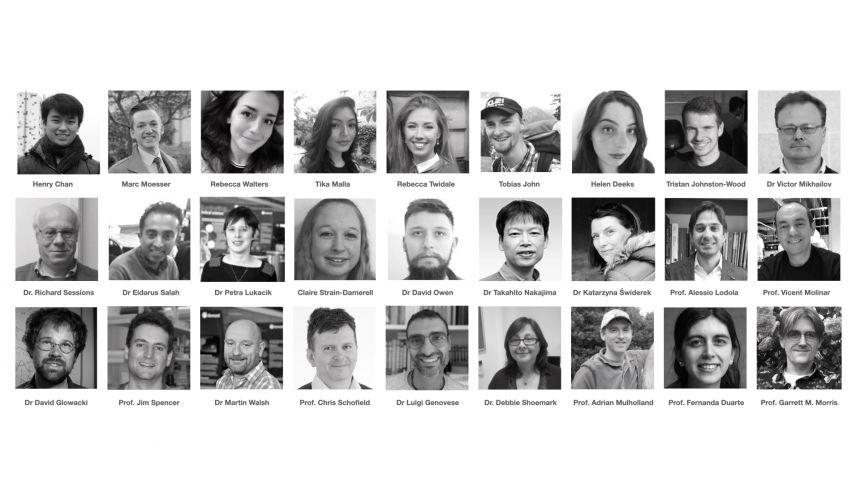 Some of the Scientists investigating SARS-COV-2 who only met virtually
Some of the Scientists investigating SARS-COV-2 who only met virtuallyEarly in the UK’s first coronavirus lockdown, Sir Patrick Stewart began to read one Shakespeare sonnet every day on his Instagram and Twitter accounts - with enthusiastic social media response. Besides the actor’s star power and Shakespeare’s fame, this response underlined how iconic the structure of the sonnet itself has become. Fourteen metrical lines in one of a number of set rhyme schemes – it is probably the most widely-recognised English verse form.
But what if the first known English sonnet was written a century earlier than thought? And what if this was an accident? This is the curious case explored in newly-published research by Dr Daniel Sawyer, of Oxford’s Merton College and English Faculty.
What if the first known English sonnet was written a century earlier than thought? And what if this was an accident?
Standard literary history says sonnets were introduced to English by Sir Thomas Wyatt in the 1520s and 30s, and first widely circulated in English in the 1557 publication of Tottel’s Miscellany. Sir Thomas imitated the much-older Italian sonnet tradition, and used an Italian rhyme scheme, which changes course at its eighth line. This structure can be seen in the rhyme words - hind, more, sore, behind, mind, afore, therefore, wind, doubt, vain, plain, about, am, tame - at the ends of the lines of his poem ‘Whoso list to hunt’, see below.
Whoso list to hunt, I know where is an hind,But as for me, hélas, I may no more.The vain travail hath wearied me so sore,I am of them that farthest cometh behind.Yet may I by no means my wearied mindDraw from the deer, but as she fleeth aforeFainting I follow. I leave off therefore,Sithens in a net I seek to hold the wind.Who list her hunt, I put him out of doubt,As well as I may spend his time in vain.And graven with diamonds in letters plainThere is written, her fair neck round about:Noli me tangere, for Caesar's I am,And wild for to hold, though I seem tame.Thomas Wyatt
If we note each rhyme sound with a new letter of the alphabet, it is abbaabba cddcee.
The particular form, favoured by Shakespeare in his sonnets, was invented by Henry Howard, Earl of Surrey. Instead of an eight-line unit and a six-line unit (an ‘octet’ and a ‘sestet’), he broke the sonnet into three four-line units and a terminal couplet. The rhymes in the Earl of Surrey’s sonnet, ‘Set me whereas the sun doth parch the green’ (see below) run as follows: green, ice, seen, wise, degree, day, be, grey, hell, flood, dwell, good, thought, nought. That is, abab cdcd efef gg.
Shakespeare wrote so successfully in this particular format that it has taken his name, rather than Surrey’s, and became the ‘Shakespearean sonnet’. So far, so straightforward: Sir Thomas Wyatt introduces the sonnet from Italian in the 16th century, and the Earl of Surrey concocts the abab cdcd efef gg pattern which Shakespeare loved.
Set me whereas the sun doth parch the green
Or where his beams may not dissolve the ice;
In temperate heat where he is felt and seen;
With proud people, in presence sad and wise;
Set me in base, or yet in high degree,
In long night or in the shortest day,
In clear weather or where mists thickest be,
In lost youth, or when my hairs are grey.
Set me in earth, in heaven, or yet in hell;
In hill, or dale, or in the foaming flood;
Thrall or at large, alive where so I dwell,
Sick or in health, in ill fame or good:
Yours will I be, and with that only thought
Content myself when that my hope is noughtHenry Howard, Earl of Surrey
Dr Sawyer argues, however, that that picture is complicated by the existence of a poem, from the middle of the 15th century, rhyming abab cdcd efef gg.
This poem is a lyric set within the larger verse adventure-story Amoryus and Cleopes, written in an experimental metre by a medieval poet, John Metham, in East Anglia, in 1448/9 – at least 70 years before Sir Thomas Wyatt introduced the sonnet to English.
Remarkably, Dr Sawyer believes, John Metham probably did not know he had written a sonnet. Italian sonnets existed, and Geoffrey Chaucer translated one in his poem Troilus and Criseyde – but he changed its form away from that of a sonnet, into three ababbcc stanzas. However, there is no known evidence to suggest John Metham either knew Italian or had access to Italian writings.
‘Had Metham wanted to write a poem recognisable as a sonnet,’ Dr Sawyer says. ‘He would have used an Italianate rhyme scheme, beginning abbaabba and then shifting into a six-line unit. But he did not.
‘He was probably writing in the tradition of the many other 15th-century English poems which were 14 lines long, discussed in Amanda Holton’s 2010 research. It is just that none of those other poems stumbled into a sonnet rhyme scheme, as this one did.’
The thought of an accidental sonnet raises big questions, according to Dr Sawyer. ‘When we say “a sonnet”, do we mean the tradition of sonnets knowingly written as sonnets, or do we mean one of the arrangements of rhymes associated with a sonnet?
If someone writes in a particular verse-form unknowingly, does the resulting poem still “count”? Are literary forms rooted in ambient cultural knowledge, or by choices of actual words?
Dr Daniel Sawyer
‘If someone writes in a particular verse-form unknowingly, does the resulting poem still “count”? Are literary forms rooted in ambient cultural knowledge, or by choices of actual words?’
There are, he adds, practical resonances to this problem too.
‘When candidates for admission to study English at Oxford look at poems in their admissions interviews, we test what they can do when faced with something unfamiliar, rather than merely gauging the surrounding cultural knowledge they bring with them into the room – that, after all, can vary a lot depending on educational background. So we need to think very carefully about what in poetry is background cultural knowledge and what is form itself.’
In his article, Dr Sawyer shows how, though it probably was not written as a sonnet, the form of John Metham’s poem still behaves quite like one: it plays different structures off against each other, with the poem splitting up in at least three different ways depending on whether it is divided by rhyme, by syntax, or by topic.
These are the same subtleties, he argues, which draw praise in later English sonnets, often as particular features of 16th- and 17th-century writing.
Following is the text of John Metham’s lyric.
O, Fortune! Alas! Qwy arte thow to me onkend?
Qwy chongyddyst thow thi qwele causeles?
Qwy art thow myne enmye and noght my frend,
And I ever thi seruant in al maner of lovlynes?
But nowe of my lyfe, my comfort, and my afyaunz
Thowe hast me beraft; that causyth me thus to compleyn:
O, bryghter than Phebus! O lyly! O grownd of plesaunz!
O rose of beauté! O most goodely, sumtyme my lady sovereyn!
But O, allas! that thru summe enmye or sum suspycyus conjecte,
I throwyn am asyde and owte of my ladii’s grace,
Sumtyme in faver, but now fro alle creaturys abjecte,
As oftyn sqwownyng as I remembyr her bryght face.
But now adwe forever, for my ful felycyté
Is among thise grene levys for to be.
Dr Sawyer’s translation is below.
O Fortune! Alas! Why are you unkind to me? Why did you change your wheel without cause? Why are you my enemy and not my friend, when I was always your servant in every kind of loveliness? But now you have taken my life, my comfort, and my trust from me; that makes me complain thus: O, brighter than Phoebus! O lily! O, foundation of love! O rose of beauty! O most excellent one, once my sovereign lady! But O, allas, that through some enemy or some jealous surmise I am thrown aside and out of my lady’s grace, once in favour, but now cast away from all creatures, swooning as often as I remember her bright face—But now, adieu forever, for all my happiness is to be among these green leaves.
John Metham
As the planet warms, and our population grows, there is an ever-increasing pressure on natural resources. It has been estimated that ‘stressed’ crops - from changing weather patterns, drought, flooding and extreme temperature - may reduce production by as much as 70%, which will have devastating impact on our ability to feed the world.
‘It’s becoming increasingly clear that such post-translational regulation of chloroplast proteins is vital for plant growth and productivity, and thus of course for food production’. Professor Paul Jarvis
It has become increasingly urgent that we develop improved crop varieties - plants with enhanced nutritional value or resilience to adverse environments - and key to this development will be our understanding of the molecular basis of plant stress tolerance.
New research from the University of Oxford, published recently in the journal eLife, sheds fresh light on plant chloroplasts, and the proteins inside them. The regulation of chloroplast proteins is important for plant development and stress acclimation and is increasingly significant as plants - including our staple crops, wheat, rice, barley - are having to respond to our changing environments.
‘As the planet warms, it will be increasingly urgent to understand the molecular basis of plant stress tolerance.’ Dr Samuel Watson
All green plants grow by converting light energy into chemical energy via a process known as photosynthesis. Photosynthesis occurs within specialised compartments of plant cells known as chloroplasts. Chloroplasts require thousands of different proteins to function, and these are imported into the chloroplast via a specialised machinery known as the TOC complex. The TOC complex is, itself, made of proteins.
Recent studies revealed that the TOC complex is rapidly destroyed when plants encounter environmental stress - this protects plant cells from damage by limiting photosynthesis, which can generate toxic by-products under adverse conditions. This process has been named CHLORAD, for “chloroplast-associated protein degradation”.
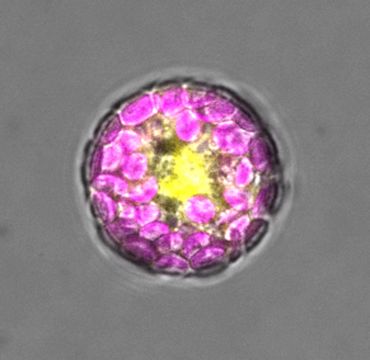 Plant cell (a protoplast) expressing the SUMO1 protein tagged with yellow fluorescent protein (YFP); the chloroplasts inside the cell are coloured magenta in this image
Plant cell (a protoplast) expressing the SUMO1 protein tagged with yellow fluorescent protein (YFP); the chloroplasts inside the cell are coloured magenta in this imageIn CHLORAD, the TOC complex is first marked with a small protein called ubiquitin. This ‘ubiquitination’ promotes the destruction of the complex, and thus suppresses chloroplast protein import, photosynthesis, and the production of toxic by-products.
‘This study has uncovered another layer of complexity within the systems that plants use to control their chloroplasts.’ Professor Paul Jarvis
In this study, researchers asked whether the TOC complex is also SUMOylated - SUMO is another small tag that is similar to ubiquitin - and, if so, what the function such TOC SUMOylation is.
The researchers found that the TOC complex is indeed SUMOylated, and that TOC SUMOylation also triggers the destruction of the TOC complex and is important for plant growth and development. These results are intriguing, as they indicate that SUMO action is very similar to that of CHLORAD, in this context.
In fact, the observed similarity with CHLORAD implies that SUMOylation regulates the activity of the CHLORAD pathway. This is particularly interesting, as SUMOylation is known to be induced by various forms of environmental stress and is a key driver of plant stress acclimation.
Professor Paul Jarvis, who supervised the work said: ‘It was remarkable when the role for ubiquitination, and CHLORAD, was discovered a few years ago, and this new role for SUMO just adds to the intrigue.’
Building on these discoveries, the researchers are currently exploring how the CHLORAD pathway can be manipulated to improve crop performance. Better understanding of the regulation of chloroplast protein import and/or the CHLORAD pathway, delivered as a result of the new findings reported here, will help to guide these efforts.
Professors of English Literature spend their lives asking the right questions, reading between the lines and interpreting texts. It is the day job. This skill means they are not the easiest people to interview; they know what you are going to ask before you ask it and they are questioning your motivation before you have finished speaking. However, Professor Abigail Williams is anything but the traditional academic and talks enthusiastically about her many lives and interests.
Professor Williams almost became an academic by accident. She never imagined becoming a Professor of English and, she says, she would have liked to go into advertising, except ‘she hadn’t really seen any adverts on television’, so did rather poorly in the interview. In an eclectic aside, she reveals she would also have liked to be a florist or a radio presenter. Apparently by chance, though, she is an Oxford scholar. Much of her work as an academic has been, quite literally, on the margins of English, studying unfashionable texts and even what readers wrote on books.
She says she is not a ‘Dead Poets’ Society’ sort, contemplating Great Literature (capital G, capital L), but then she talks about holding classes in museums and sounds quite a lot like the unconventionally inspirational teacher of English (capital E).
Professor Williams is not a ‘Dead Poets’ Society’ sort, contemplating Great Literature (capital G, capital L)
It is hard to keep up with the Humanities academic lead for Innovation. Professor Williams talks excitedly about her lockdown project - an interactive ‘game’ for teenagers, where they have WhatsApp-style ‘conversations’ with characters from Shakespeare’s Romeo and Juliet. Typically focusing on the language, she does not use the term ‘game’ since young gamers see her ‘game’ as a very poor substitute for Grand Theft Auto. But, call it a ‘learning resource’, she says, and they love it. It is all about words.
Professor Williams loves to take English out of context and clearly enjoys breaking a few moulds on the way. From games, (sorry, learning resources), to working with a perfumer, on a range of historically-inspired fragrances, to musing on ‘Between the Sheets’, as an appropriate title for a forthcoming book on reading in bed, Professor Williams confounds conventional stereotypes and seeks to reach wider audiences with her love of literature.
Born in London, but raised on a commune in Dorset, she did not have the most conventional start. It was not the sort of troubling 1970s communal experience, which features from time to time in the popular press, but a collection of professional people who gave up the professions they were good at, to do things they were not really good at, she laughs.

In an early example of her atypical journey, she went from her commune to a scholarship place at a prestigious local convent school.
‘I really liked English,’ she says. ‘We had some very impressive English teachers, I suppose, in a Dead Poets’ Society way...but that is not the sort of English I have ever done.’
She won a place from the convent to come to Oxford to study English, potentially the last conventional thing she has done.
‘It was amazing, eye opening,’ says Professor Williams. ‘When you arrive, you do a lot of comparing with other people and, suddenly, you may have been the best at school, but now you realise you’re just one fish in a big sea....It took a while before I found what I was good at.’
Leaving the university on graduation, she enjoyed exploring opportunities but was, as she cheerfully admits, woefully unprepared for her chosen career of advertising.
‘My interview was a disaster,’ she says with amusement. ‘How could I talk about something, when I knew nothing about it?’
So she returned to Oxford for postgraduate study and took an MPhil in 18th century literature, ‘It was a brilliant course, a really good grounding.’
It was then that Professor Williams’s journey took another sideways move - she began studying less well known 18th century poetry, not Pope or Swift or the other acclaimed Tory poets, but their forgotten Whig counterparts. Very popular in their day, but now virtually unknown, these poets were given to paeans of praise about William III and his bloody wars. To modern ears, they are ‘dreadful’, according to Professor Williams. But she is intrigued by the fact that they were so popular and praised when written.
‘They were thought terrific in their day but seem so recherché and unpalatable now,’ she says. ‘People say great art transcends time, but Whig poets wrote about things which no one would want to read about now. It is awful jingoistic dross and yet at the time was loved by the most successful people in the country.
‘I want to understand the head set of that; the psychology of that aesthetic change.’
People say great art transcends time, but Whig poets wrote about things which no one would want to read about now. It is awful jingoistic dross and yet at the time was loved...I want to understand the head set of that; the psychology of that aesthetic change
Professor Williams
Another less popular area of research, which is a great interest of Professor Williams, is ‘marginalia’: what people wrote on their books, the underlinings, the notes, the words in the margins. She is interested in what people were saying about their books and, like the Whig poetry, how historical readers might be different from modern ones. In future, she predicts, scholars will look at social media to interpret the reception of literature, as well as the marginalia.
With growing debate about content warnings and offensive material in historical works,’ Professor Williams says it is important to recognise that novels in particular have always been controversial and ‘dangerous’.
‘Northanger Abbey was all about the dangers of novel reading,’ she says. ‘It has always been a matter of concern; the isolated reader, getting inside the consciousness of the writer. We worried in the 18th century about some kinds of novels and their content and we worry now about different ones. Students might register discomfort at some texts, but this is the reality of literature and what we are here to explore.'
And, she says enthusiastically, ‘English has become more global, we talk about Englishes and the range of writers has expanded, there is more diversity. We’re less hung up now on doing things the way they were when we were students.’
Northanger Abbey was all about the dangers of novel reading...It has always been a matter of concern; the isolated reader, getting inside the consciousness of the writer. We worried in the 18th century about some kinds of novels and their content and we worry now about different ones. Students might register discomfort at some texts, but this is the reality of literature and what we are here to explore
She adds, ‘It’s great to help students understand the world the works were written in, so how better to understand Georgian novels than to spend an afternoon looking at tea pots and snuff boxes at the museum...it’s a better way of teaching.’
Professor Williams is determined to see the enjoyment brought by literature spread, which is why she threw herself into developing Will Play, her Shakespearean learning resource, during the pandemic.
‘It was trialled at my children’s school...I wore a hoodie to disguise myself, because they were so embarrassed...it was great fun to see them use it. It became a gateway into reading.
‘English Literature teaching has always used different routes...you can empathise with the characters, engage with the texts...it was really exciting seeing how Shakespeare was embraced.
‘They really got into it, messaging the characters and even warning them about what was going to happen.’
There has developed a link between cleverness and obscurity, with almost a contempt for language that is understood. I would like to uncouple those things....You should be able to say something clearly
Professor Williams is almost evangelical in her wish to reach out to audiences, admitting that she would also have liked to be a radio presenter, underlining her emphasis on the importance of communication. She maintains, ‘There has developed a link between cleverness and obscurity, with almost a contempt for language that is understood. I would like to uncouple those things.’
Before disappearing into the Oxford street, the Professor of English Literature says thoughtfully, ‘You should be able to say something clearly.’
 Prof. Jonathan Doye
Prof. Jonathan DoyeMost people who have done some chemistry will have seen examples of how the directionality of the covalent bonding for a given element can determine the crystal structures they form. For example, the tetrahedral bonding of carbon atoms naturally leads to the crystalline structure of diamond. But to better understand this challenge, we first need to explain what a quasicrystal is.
We should start with a discovery of Sir Roger Penrose, an Oxford mathematician and physicist who won the Nobel Prize for Physics in 2020. In 1974 he showed that one could tile a plane with just two types of tiles, such that the tiling has no repeating pattern but has a kind of 5-fold symmetry that is not possible for crystals. These Penrose tilings, one of which is shown below, are said to have “quasiperiodic order”.
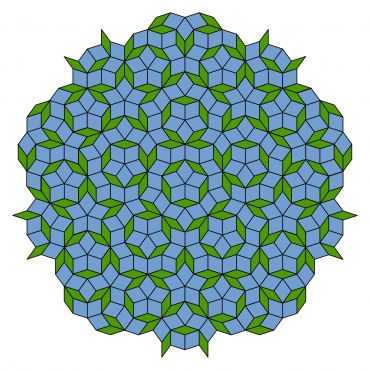 An example of a Penrose tiling
An example of a Penrose tiling
The order of these quasicrystals is revealed by the diffraction patterns that result when electrons or x-rays pass through them. They are labelled as icosahedral, because like the icosahedron that is one of the Platonic solids, there are six axes along which five-fold symmetry is revealed in the diffraction patterns. Like crystals, this underlying symmetry can also be revealed by the shapes into which quasicrystals grow, such as the dodecahedron below. Dan Shechtman’s paradigm-shifting discovery led to him receiving the Nobel Prize in Chemistry in 2011.
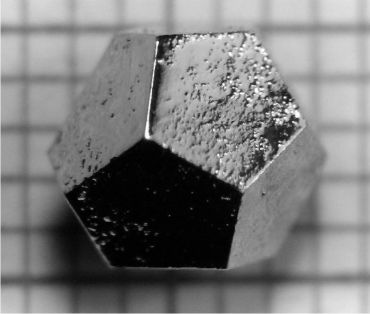 A large quasicrystal with a docahedral shape that is a consequence of its underlying non-crystallographic icosahedral symmetry
A large quasicrystal with a docahedral shape that is a consequence of its underlying non-crystallographic icosahedral symmetryThis discovery led to an intense search for other examples of icosahedral quasicrystals. Many were found, including even natural examples in meteorites, but all were metallic alloys, whereas none have been found in covalent materials where the bonding is directional.
This raises the question of whether, if one is not restricted by the geometry of covalent bonding that is allowed by atoms, it might be possible to design particles that could form icosahedral quasicrystals through directional bonding. In 2014 Eva González Noya, my collaborator at CSIC in Madrid, and myself set ourselves the task of finding computational models that could achieve this.
One of the challenges we faced is that the structure of quasicrystals is more complex to describe than periodic crystals. For example, if one has the diffraction pattern for a crystal, one can work out exactly where all the atoms are in the unit cell. However, for an icosahedral quasicrystal, one instead gets a description of the quasicrystal in terms of a crystal in six dimensions!
Some help came from computational experiments by the group of Sharon Glotzer at the University of Michigan in which icosahedral quasicrystals formed in systems without directional bonding. Although these provided examples where the positions of all the particles were known, they revealed another challenge: although the icosahedral quasicrystals have beautiful long-range order, locally they are quite disordered. For example, if one was to try to have particles that reproduce all the different patterns of local bonding in this example, the number of types of particles needed would be far too large to be practical.
Progress was gradually made, a key insight being that one should not be too fussy about whether a particle is able to form all its possible directional bonds, and in 2018 a first example system consisting of five particle types was found that assembled into an icosahedral quasicrystal in simulations; later, this was simplified to a system of two particle types.
And to show the generality of the design principles, a second quasicrystal-forming system was developed that had a totally different pattern of local directional bonding. Somewhat like the metallic alloy examples, key building blocks are icosahedral clusters (the yellow and cyan rhombic triacontahedra in the image below) which form in a matrix of particles that propagates the global order.
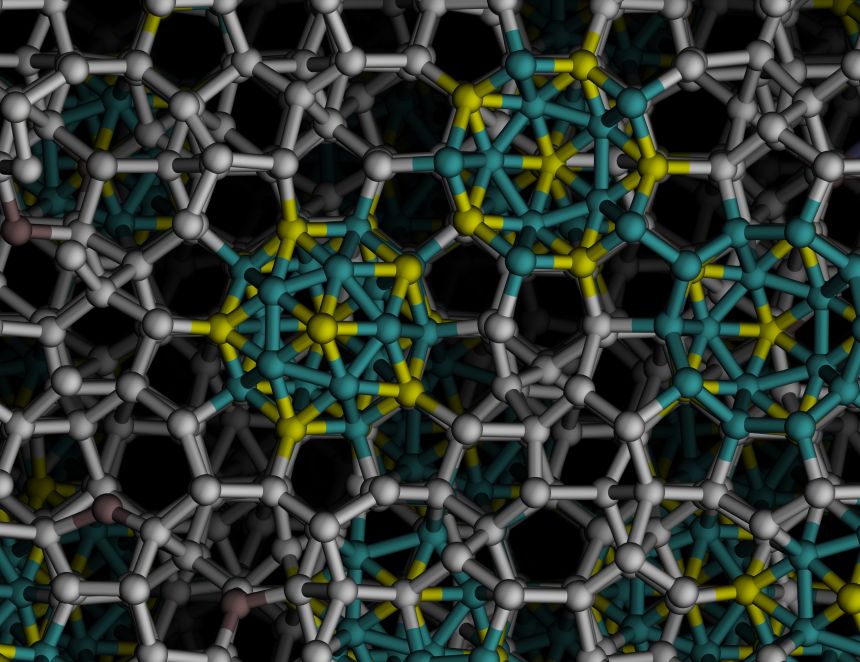 A close-up of a cut through one of the icoshedral quasicrystals grown in our computational experiments viewed along a five-fold axis of symmetry.
A close-up of a cut through one of the icoshedral quasicrystals grown in our computational experiments viewed along a five-fold axis of symmetry.Of course, an important question is whether these computationally discovered quasicrystals could be realized experimentally. Although it is unlikely that they could be formed by atomic materials, atoms are not the only particles that form crystals. Nanoparticles and colloidal particles can also form crystals; for example, precious opals are crystals of colloidal silica spheres and their iridescence results from the diffraction of light by these crystals.
Recently, crystals made up from building blocks made of DNA have been realized. The beauty of these DNA nanotechnology techniques is that the shape of the DNA particles and the interactions between them can be almost arbitrarily controlled. Computational modelling of such DNA particles suggests that making icosahedral quasicrystals from DNA origami particles could well be feasible.
How to design an icosahedral quasicrystal through directional bonding, Published 18th August 2021, Nature.
- ‹ previous
- 15 of 248
- next ›
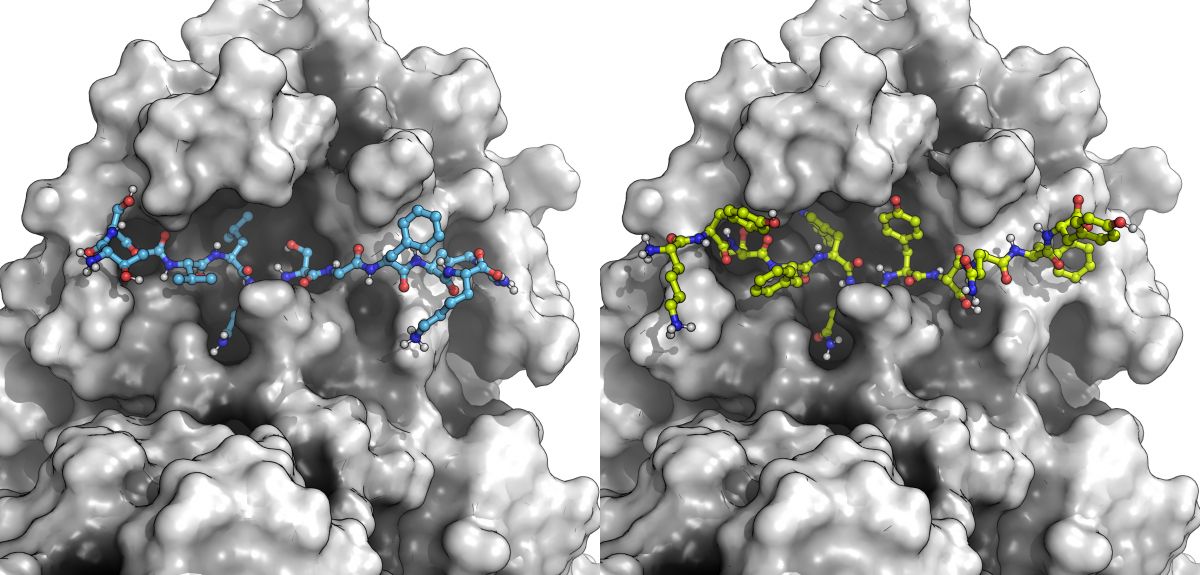
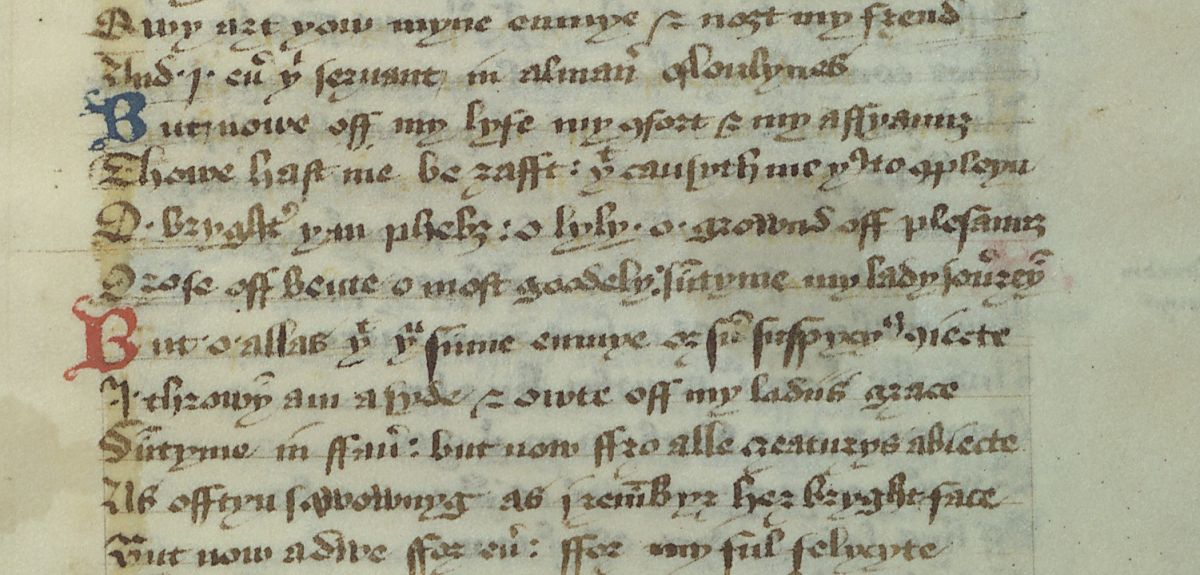
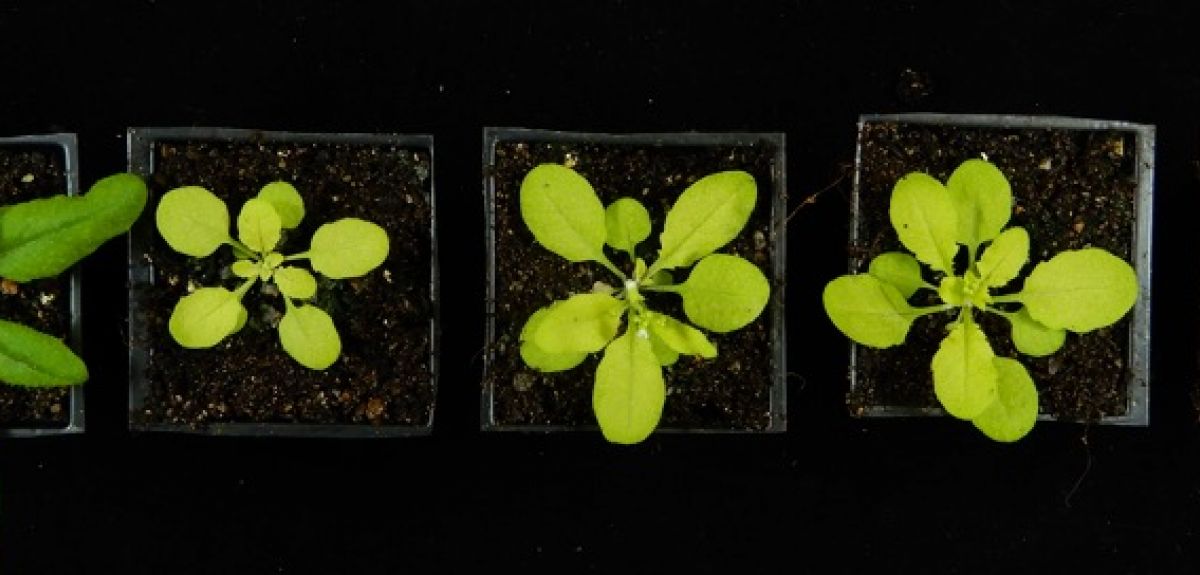

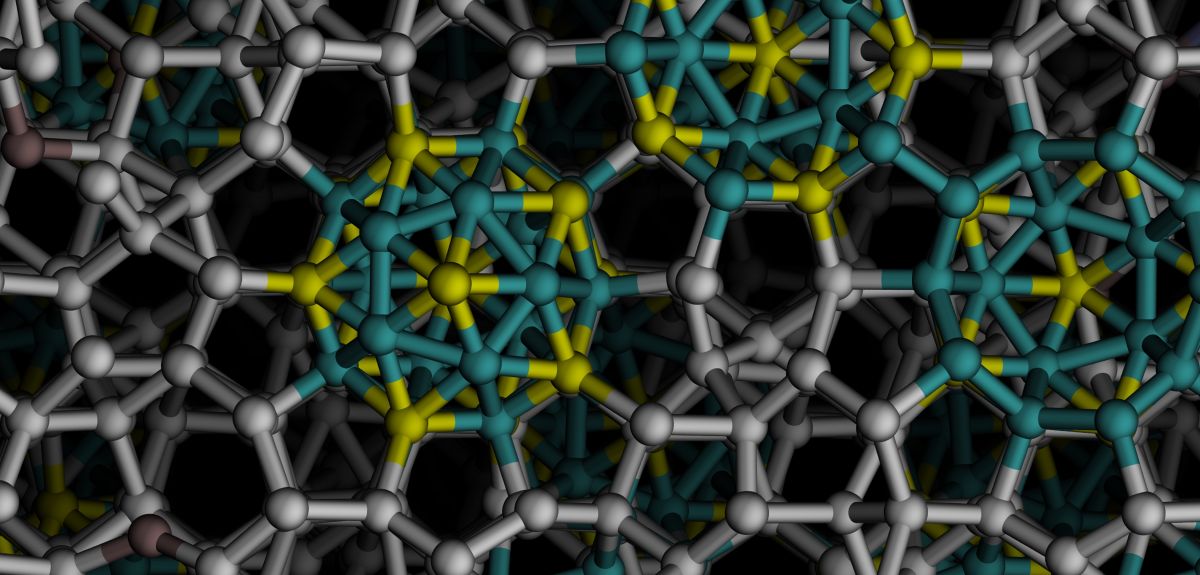
 Teaching the World’s Future Leaders
Teaching the World’s Future Leaders  A blueprint for sustainability: Building new circular battery economies to power the future
A blueprint for sustainability: Building new circular battery economies to power the future Oxford citizen science project helps improve detection of antibiotic resistance
Oxford citizen science project helps improve detection of antibiotic resistance The Oxford students at the forefront of the fight against microbial resistance
The Oxford students at the forefront of the fight against microbial resistance  The hidden cost of AI: In conversation with Professor Mark Graham
The hidden cost of AI: In conversation with Professor Mark Graham  Astrophoria Foundation Year: Dr Jo Begbie reflects on the programme’s first year
Astrophoria Foundation Year: Dr Jo Begbie reflects on the programme’s first year World Malaria Day 2024: an interview with Professor Philippe Guerin
World Malaria Day 2024: an interview with Professor Philippe Guerin From health policies to clinical practice, research on mental and brain health influences many areas of public life
From health policies to clinical practice, research on mental and brain health influences many areas of public life From research to action: How the Young Lives project is helping to protect girls from child marriage
From research to action: How the Young Lives project is helping to protect girls from child marriage